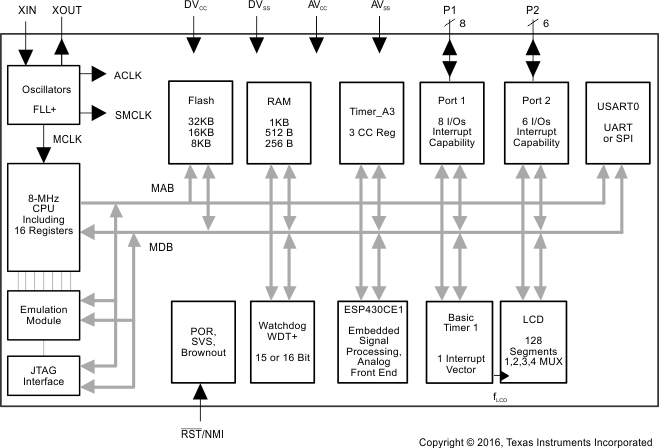JAJS273D July 2003 – November 2016 MSP430FE423 , MSP430FE425 , MSP430FE427
PRODUCTION DATA.
- 1デバイスの概要
- 2改訂履歴
- 3Device Comparison
- 4Terminal Configuration and Functions
-
5Specifications
- 5.1 Absolute Maximum Ratings
- 5.2 ESD Ratings
- 5.3 Recommended Operating Conditions
- 5.4 Supply Current Into AVCC and DVCC Excluding External Current
- 5.5 Thermal Resistance Characteristics, PM Package (LQFP64)
- 5.6 Schmitt-Trigger Inputs − Ports (P1 and P2), RST/NMI, JTAG (TCK, TMS, TDI/TCLK,TDO/TDI)
- 5.7 Inputs P1.x, P2.x, TAx
- 5.8 Leakage Current − Ports (P1 and P2)
- 5.9 Outputs − Ports (P1 and P2)
- 5.10 Output Frequency
- 5.11 Typical Characteristics - Ports P1 and P2
- 5.12 Wake-up Time From LPM3
- 5.13 RAM
- 5.14 LCD
- 5.15 USART0
- 5.16 POR, BOR
- 5.17 SVS (Supply Voltage Supervisor and Monitor)
- 5.18 DCO
- 5.19 Crystal Oscillator, LFXT1 Oscillator
- 5.20 ESP430CE1, SD16 and ESP430 Power Supply and Operating Conditions
- 5.21 ESP430CE1, SD16 Input Range
- 5.22 ESP430CE1, SD16 Performance
- 5.23 ESP430CE1, SD16 Temperature Sensor
- 5.24 ESP430CE1, SD16 Built-in Voltage Reference
- 5.25 ESP430CE1, SD16 Reference Output Buffer
- 5.26 ESP430CE1, SD16 External Reference Input
- 5.27 ESP430CE1, Active Energy Measurement Test Conditions and Accuracy
- 5.28 ESP430CE1, Active Energy Measurement Test Conditions and Accuracy
- 5.29 ESP430CE1 Typical Characteristics (I1 SD16GAINx = 1)
- 5.30 ESP430CE1 Typical Characteristics (I1 SD16GAINx = 4)
- 5.31 ESP430CE1 Typical Characteristics (I1 SD16GAINx = 8)
- 5.32 ESP430CE1 Typical Characteristics (I1 SD16GAINx = 32)
- 5.33 Flash Memory
- 5.34 JTAG Interface
- 5.35 JTAG Fuse
-
6Detailed Description
- 6.1 CPU
- 6.2 Instruction Set
- 6.3 Operating Modes
- 6.4 Interrupt Vector Addresses
- 6.5 Special Function Registers
- 6.6 Memory Organization
- 6.7 Bootloader (BSL)
- 6.8 Flash Memory
- 6.9 Peripherals
- 6.10
Input/Output Diagrams
- 6.10.1 Port P1 (P1.0 and P1.1) Input/Output With Schmitt Trigger
- 6.10.2 Port P1 (P1.2 to P1.7) Input/Output With Schmitt Trigger
- 6.10.3 Port P2 (P2.0 and P2.1) Input/Output With Schmitt Trigger
- 6.10.4 Port P2 (P2.2 to P2.5) Input/Output With Schmitt Trigger
- 6.10.5 Port P2 (P2.6 and P2.7) Unbonded GPIOs
- 6.10.6 JTAG Pins TMS, TCK, TDI/TCLK, TDO/TDI, Input/Output With Schmitt-Trigger or Output
- 6.10.7 JTAG Fuse Check Mode
- 7デバイスおよびドキュメントのサポート
- 8メカニカル、パッケージ、および注文情報
1 デバイスの概要
1.1 特長
- 低い電源電圧範囲: 2.7V~3.6V
- 超低消費電力
- アクティブ・モード: 1MHz、3Vで400µA
- スタンバイ・モード: 1.6µA
- オフ・モード(RAM内容の保持):0.1µA
- 5つの省電力モード
- スタンバイ・モードから6µs以内にウェークアップ
- 周波数ロック・ループ、FLL+
- 16ビットRISCアーキテクチャ、命令サイクル・タイム125ns
- 単相エネルギー測定用の信号処理を内蔵、アナログ・フロント・エンドと温度センサを搭載(ESP430CE1)
- 16ビットのTimer_A (3つのキャプチャ/コンペア・レジスタ付き)
- 128セグメント用のLCDドライバを搭載
- シリアル通信インターフェイス(USART)、非同期UARTまたは同期SPIをソフトウェアで選択可能
- ブラウンアウト検出器
- 電源電圧スーパーバイザとモニタ、プログラムにより検出レベルを設定可能
- シリアル・オンボード・プログラミング、外部のプログラミング電圧不要、セキュリティ・ヒューズによるプログラム可能なコード保護
- ブートローダー(BSL)
- ファミリ製品:
- MSP430FE423
8KB + 256Bのフラッシュ・メモリ、256BのRAM - MSP430FE425
16KB + 256Bのフラッシュ・メモリ、512BのRAM - MSP430FE427
32KB + 256Bのフラッシュ・メモリ、1KBのRAM
- MSP430FE423
- 64ピンのクワッド・フラット・パック(LQFP)で供給
- モジュールの完全な説明については、『MSP430x4xxファミリ・ユーザーズ・ガイド』を参照
1.2 アプリケーション
- 2線式および3線式の単相メータ
- 改ざん防止メータ
1.3 概要
TI MSP430™ファミリの超低消費電力マイクロコントローラは複数のデバイスで構成され、それぞれが各種のアプリケーションを対象とする異なるペリフェラルを搭載しています。このアーキテクチャは5つの低消費電力モードを持ち、携帯用測定器用途でバッテリ駆動時間を延長するよう最適化されています。このデバイスには、強力な16ビットRISC CPU、16ビット・レジスタ、およびコンスタント・ジェネレータが搭載されており、コード効率が最大限に発揮されます。デジタル制御発振器(DCO)により、デバイスは低消費電力モードからアクティブ・モードへ6µs以内にウェークアップできます。
MSP430FE42xシリーズは、3つの独立した16ビットのシグマ-デルタADCと、内蔵の信号プロセッサ・コアを持つマイクロコントローラ構成であり、2線式および3線式の両方の構成で単相エネルギーを測定、計算するため使用されます。また、16ビットのタイマ、128セグメントのLCDドライブ機能、14本のI/Oピンも搭載されています。
代表的なアプリケーションは、変更を加えることのできない堅牢なメータなど、2線式および3線式の単相計測です。
製品情報(1)
| 型番 | パッケージ | 本体サイズ(2) |
|---|---|---|
| MSP430FE427IPM | LQFP (64) | 10mm×10mm |
| MSP430FE425IPM | LQFP (64) | 10mm×10mm |
| MSP430FE423IPM | LQFP (64) | 10mm×10mm |
(1) 提供中の全デバイスに関する最新の製品、パッケージ、および注文情報についてはSection 8の「付録:パッケージ・オプション」またはwww.ti.comのTI Webサイトを参照してください。
(2) ここに記載されているサイズは概略です。許容公差を含めたパッケージの寸法については、Section 8の「メカニカル・データ」を参照してください。
